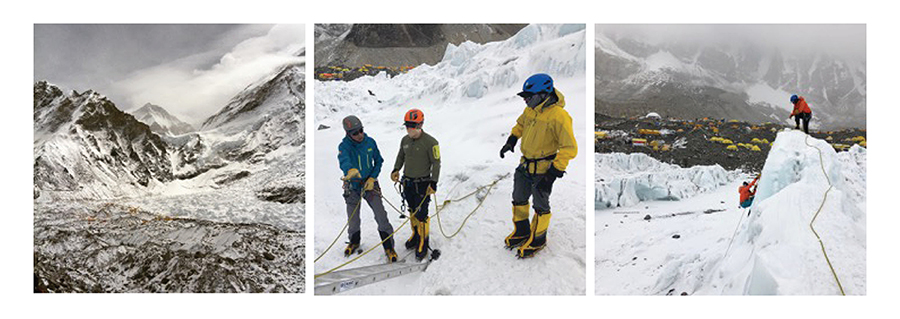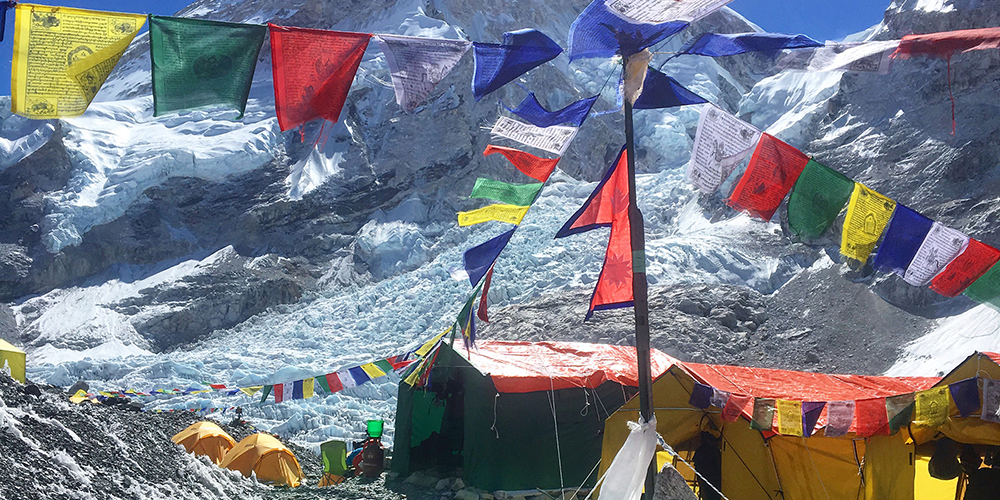We have finally reached Everest Basecamp and after a few days of well-deserved rest, it is time to start our training in earnest. It’s hard to imagine a better place to put an edge on mountaineering skills that may have become a bit rusty and dull during time spent away from the mountains. The camp sits on the Khumbu Glacier just below the infamous icefall of the same name. Situated on the northern side of the valley, the tents rest on platforms hacked into the enormous boulder fields that have avalanched over and partially covered the retreating glacier. Just below the camp, exposed ice towers flow in frozen waves for miles eventually fading out of sight to the west. This is home for the next month and where we will spend the next week identifying the gaps and deficiencies in our skills, erasing them, learning new and more efficient techniques and preparing to climb the highest mountain on earth.

A good training program has requirements that are rarely met and when done properly, they are every bit as daunting for the trainer as they are for the trainee. Imagine giving a group of mountain climbers a PowerPoint presentation on various knots, gear, techniques and the proposed climbing route, and then turning them loose on some vast and glaciated mountain. This is obviously a ludicrous proposition, likely to fail, quite possibly in a catastrophic and severely damaging manner. If this is the extent and depth of your own training programs, whether you are attending a session or attempting to relay the information, there is no reason to expect any other result. If you would absorb new information, or teach it, you should understand the basic and common components necessary to a productive training session.
The first component is engagement. It is absolutely necessary to involve the student. Good instructors find this difficult because it requires her to challenge the knowledge and skill set of the student. This can easily scare, embarrass or intimidate the student which, in turn, ruins the learning environment. This brings us to the second critical component.
For anyone to learn and absorb information, the learning environment has to be safe. In the case of mountaineering, we are addressing the actual physical aspects of the environment. And, just as importantly, we are guarding the pride, competence and self-determinism of the individual. Mistakes are not pounced on, but gently pointed out and corrected. The instructor is ready with not only encouragement, but with a litany of his own mistakes to share and reassure the student that mistakes are a natural part of the learning process, and once discovered, easily correctable. The amount of laughter is a good indicator of success.
The third critical component of good training is to impart the “why” to the student. It is well understood and documented that adults need to understand why they are doing something in order to absorb and use the new information. Without this anchor, the knowledge seems to float unattached and eventually dissipate, unused and forgotten. This is most easily done by showing or demonstrating the consequences of these failures and mistakes. Using case studies or relaying anecdotes of failure are great ways to bring these lessons home.
Once the why is established and the correct technique or procedure is known, the only remaining critical component for the student is for him to demonstrate competence. This takes practice and requires the student to drill, over and over, until all mistakes have been eliminated. The instructor stays with the student until the new knowledge, technique or skill is demonstrated perfectly. We know we are getting close to success when nervous questions give way to demands to get going. When our climbers are racing through the obstacle courses we throw at them and complaining of their ease and boredom; then we will know it’s time to go up.
All the best
Fred Alldredge
Everest Base Camp, Nepal
Facebook: Fred P Alldredge
Instagram: fredall99


